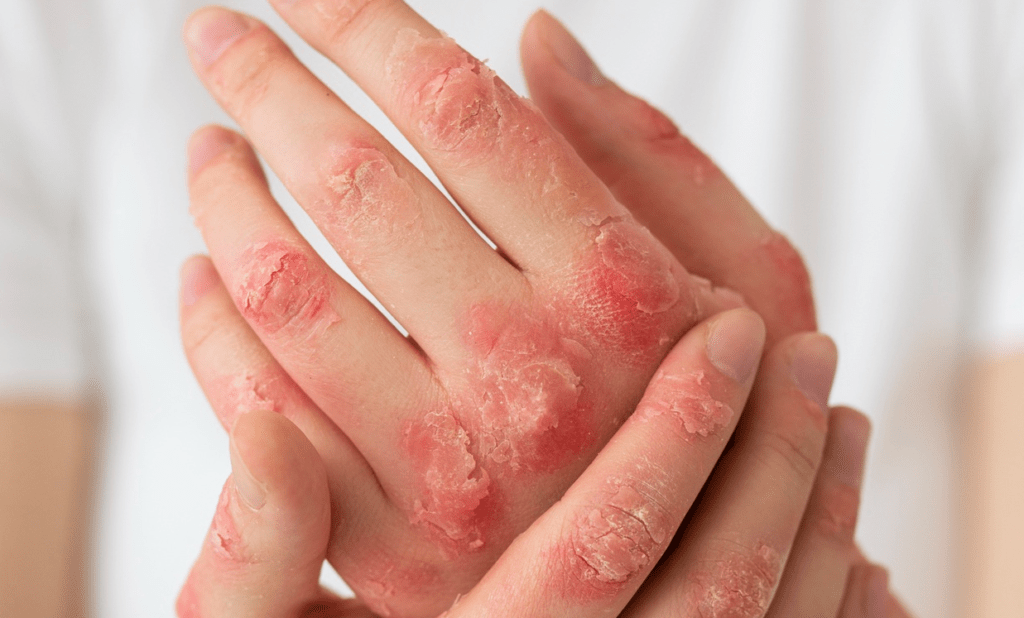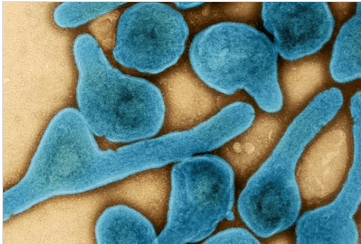It is commonly believed that hand, foot, and mouth disease is a minor childhood annoyance that is linked to early bedtime and cartoon bandages. However, this presumption has been seriously contested in recent months. Adults in a variety of settings, including marketing firms and medical clinics, are increasingly coming into contact with the virus—not only as unwitting patients but also as passive caregivers. Unexpectedly, the effects are more upsetting—physically excruciating, awkward in social situations, and sometimes expensive for one’s career.
Understanding Hand, Foot, and Mouth Disease in Adults: Breaking the Myths
⚠️ Important Clarification
Hand, Foot, and Mouth Disease (HFMD) is NOT the same as Foot-and-Mouth Disease:
| Aspect | Hand, Foot, and Mouth Disease (HFMD) | Foot-and-Mouth Disease |
|---|---|---|
| Affects | Humans (especially children, but also adults) | Livestock only (cattle, pigs, sheep) |
| Caused by | Coxsackievirus A16, Enterovirus 71 | Aphthovirus |
| Transmission to humans | Yes – highly contagious between people | No – cannot infect humans |
Hand Foot and Mouth Disease Symptoms in Adults: What to Watch For
HFMD in adults often presents differently than in children. Adults typically experience more severe symptoms that can significantly impact daily activities.
Symptom Progression Timeline
Days 1-2: Initial Phase
- Fever (101-103°F) Moderate
- Sore throat and difficulty swallowing
- General malaise and fatigue
- Loss of appetite
Days 3-5: Rash Development
- Painful mouth sores (inside cheeks, tongue, gums) Severe
- Red spots on palms and soles that develop into blisters
- Rash may extend to buttocks, knees, and elbows in adults
- Intense itching and burning sensation
Days 6-10: Peak Symptoms
- Blisters may merge and become extremely painful
- Difficulty walking due to foot blisters Severe
- Inability to use hands for daily tasks
- Dehydration risk due to painful swallowing
Days 10-14: Recovery Phase
- Blisters begin to dry and crust over
- Skin peeling on hands and feet
- Gradual return of appetite
- Fatigue may persist for weeks
🚨 Unique Adult Symptoms Often Missed:
- Nail Changes: Fingernails and toenails may fall off 1-2 months after infection (onychomadesis)
- Joint Pain: Adults report arthritis-like symptoms lasting weeks
- Neurological Effects: Headaches, dizziness, and in rare cases, viral meningitis
- Prolonged Fatigue: Post-viral syndrome lasting 4-6 weeks
While hand foot and mouth disease in adults is less common than in children, it’s becoming increasingly prevalent. Adults often experience more severe symptoms and face unique challenges in diagnosis and treatment. This “silent outbreak” affects thousands of adults annually, yet remains underdiagnosed due to misconceptions that it’s exclusively a childhood illness.
Adults frequently confuse early symptoms for unrelated problems, in contrast to toddlers, whose symptoms are quickly noticed by vigilant parents. A low-grade fever and general exhaustion, which feel remarkably similar to common seasonal illnesses, may be the first symptoms of the illness. But after a few days, the symptoms become obvious: tiny, blister-like sores on the hands, feet, or inside the mouth. It is only at that point that many realize that this isn’t stress but rather hand, foot, and mouth disease, which can affect adults as well.
Table: Key Information on Hand, Foot, and Mouth Disease in Adults
| Attribute | Information |
|---|---|
| Affected Demographic | Typically children, but increasing incidence in adults |
| Common Symptoms in Adults | Fever, sore throat, painful mouth ulcers, rash on hands and feet, fatigue, occasional nausea |
| Typical Duration | Usually clears up in 7 to 10 days |
| Virus Type | Commonly caused by Coxsackievirus A16 or Enterovirus 71 |
| Modes of Transmission | Via droplets, saliva, feces, blister fluid, or contaminated surfaces |
| Contagious Period | Highest in the first week; virus can still be shed after symptoms resolve |
| Risk for Adults | Typically mild, but often underdiagnosed; adults can be asymptomatic carriers |
| Preventative Measures | Frequent handwashing, surface disinfection, avoiding contact during active symptoms |
| Medical Treatment | Supportive only—hydration, pain management, soft food diet, mouth rinses |
| Trusted Source | Penn Medicine on HFMD |
The condition often presents with unusual severity in adult patients. Speaking and eating can become uncomfortable due to the excruciating pain of mouth ulcers. Movement may be restricted by blisters on the fingers or soles of the feet, especially for people with physically demanding jobs. The blisters were “like stepping on thorns with every move,” according to a professional dancer in London who recently shared her experience. These accounts demonstrate how this ostensibly harmless illness can ruin parenting, fitness regimens, and even careers.

What Causes HFMD in Adults? Understanding Viral Infections
🦠 Primary Causative Agents
Coxsackievirus A16 and Enterovirus 71 are the main culprits behind viral infections in adults that cause HFMD. These viruses belong to the enterovirus family and thrive in warm, humid conditions.
- Coxsackievirus A16: Most common cause (60% of cases)
- Enterovirus 71: Associated with more severe symptoms (25% of cases)
- Other Enteroviruses: Including Coxsackievirus A6, A10 (15% of cases)
How Adults Contract HFMD: Transmission Routes
👋 Direct Contact
Contact with blister fluid, saliva, or nasal secretions
HIGH RISK💨 Respiratory Droplets
Coughing, sneezing, or close conversation
HIGH RISK🚽 Fecal-Oral Route
Poor hand hygiene after bathroom use
MEDIUM RISK🏠 Contaminated Surfaces
Doorknobs, keyboards, shared items
MEDIUM RISKWhy Adults Are Increasingly Affected
- Childcare Exposure: Parents and childcare workers face repeated exposure
- Weakened Immunity: Stress, lack of sleep, and poor diet reduce resistance
- New Virus Strains: Emerging variants that adults haven’t been exposed to
- Global Travel: Increased exposure to different viral strains
Treatment for HFMD in Adults: Managing Symptoms Effectively
While there’s no specific cure for treatment for HFMD in adults, symptom management is crucial for recovery and preventing complications.
Medical Treatments
| Symptom | Recommended Treatment | Dosage for Adults | Notes |
|---|---|---|---|
| Fever & Pain | Acetaminophen or Ibuprofen | 500-1000mg every 4-6 hours | Do not exceed daily limits |
| Mouth Sores | Lidocaine mouth rinse | 15ml swish and spit every 3 hours | Prescription required |
| Skin Blisters | Calamine lotion or hydrocortisone | Apply 3-4 times daily | Avoid breaking blisters |
| Dehydration | Oral rehydration solutions | Small sips throughout day | IV fluids if severe |
🏠 Effective Home Remedies for Adults
- Salt Water Rinses: ½ teaspoon salt in warm water, gargle 4-6 times daily
- Ice Pops/Cold Foods: Numbs mouth pain and prevents dehydration
- Baking Soda Paste: For skin blisters – mix with water, apply for 10 minutes
- Coconut Oil: Natural antiviral properties, apply to blisters
- Aloe Vera Gel: Soothes burning sensation on hands and feet
When to Seek Emergency Care
- Signs of dehydration (dark urine, dizziness, dry mouth)
- High fever lasting more than 3 days
- Severe headache or neck stiffness
- Difficulty breathing or chest pain
- Confusion or altered mental state
It’s interesting to note that adult cases are often misdiagnosed or ignored entirely. Sometimes, mouth sores are caused by acid reflux or dental irritation. A palm rash could be mistaken for a minor allergic reaction. Accurate identification is delayed when patients and providers do not communicate clearly. A number of family members or coworkers may have already been exposed by the time a diagnosis is made.
The misconception that HFMD doesn’t affect adults has made it possible for it to covertly spread, particularly in high-contact settings. Workplaces with shared kitchens, desks, and touchscreens turn into hotspots for transmission. Fitness centers have also turned into unanticipated gathering places where the virus is silently spread by shared mats or towels. Proactive hygiene is especially helpful in these areas, especially during seasonal outbreaks.
For the majority of healthy adults, HFMD is not dangerous despite being contagious. Nevertheless, its symptoms have the power to drastically disrupt everyday life. A few canceled plans and missed meetings soon add up to a loss of productivity. A sore throat or noticeable rash is not only uncomfortable, but it can paralyze a person’s career in professions where communication is essential, such as teaching, broadcasting, or customer service.
Public awareness of hygiene greatly increased during the pandemic. Now, that increased awareness acts as a useful buffer. Adults can greatly lower the risk of transmission by utilizing handwashing, frequent disinfection, and brief isolation. Despite the lack of a vaccine at this time, outbreaks have been effectively contained by these low-tech measures.
Although non-specific, treatment is controllable. To relieve pain, doctors usually prescribe over-the-counter drugs like ibuprofen or paracetamol. When mouth ulcers flare up, it’s especially helpful to consume cool liquids and soft foods like applesauce or yogurt. Despite being underappreciated, rest is essential. Complications like viral meningitis can occur in rare cases of Enterovirus 71, especially in immunocompromised people, highlighting the importance of early detection.
Many researchers are currently investigating whether adult recurrent infections are caused by new viral strains that evade established defenses or by weakened childhood immunity. Research has already demonstrated that the virus does not permanently impair immunity. For people who work in childcare, healthcare, or public-facing positions where repeated exposure is likely, this poses especially significant questions. In these situations, routine symptom awareness and increased surveillance may be very helpful.
The discomfort and disruption that HFMD causes have also affected celebrities. A number of performers have had to postpone appearances because of viral symptoms, although this has rarely been reported. Actors and musicians have acknowledged in private interviews that they have concealed outbreaks under gloves or makeup to evade attention. The stigma associated with “childhood diseases” has unintentionally deterred adults from recognizing or reporting symptoms, which has increased spread and delayed containment.
Clinics in urban areas have noted a minor rise in adult consultations for symptoms of HFMD in recent months. Several regional health agencies have updated their public advisories in response to this trend, especially during periods of high transmission. In addition to emphasizing the value of cleanliness, these advisories also highlight the urgent need to de-stigmatize adult cases. Promoting early reporting can greatly limit the virus’s spread.
The fact that HFMD is still self-limiting for most patients, even though it is extremely contagious, is particularly encouraging. After the blisters have crusted over, the risk of spreading the virus significantly decreases, and most people recover completely in ten days. However, some adults, especially those with other medical conditions, may find that their downtime is prolonged by persistent fatigue or skin sensitivity.
Campaigns for public education that stress shared responsibility could have a significant influence in the future. During viral peaks, businesses may need to develop flexible sick leave policies. For people, it might just mean remaining at home when the first symptoms show up. When strategically applied, these minor changes can have a significant positive impact on public health.
Preventing Hand Foot and Mouth Disease in Adults
Prevention is crucial, especially for adults in high-risk environments like healthcare, childcare, or those with compromised immune systems.
🧼 Personal Hygiene
- Wash hands for 20 seconds with soap and water
- Use 60%+ alcohol hand sanitizer when soap unavailable
- Avoid touching face with unwashed hands
- Cover coughs and sneezes with tissue or elbow
🏠 Environmental Controls
- Disinfect surfaces daily with bleach solution
- Don’t share utensils, cups, or towels
- Wash contaminated clothing in hot water
- Ventilate indoor spaces regularly
👥 Social Precautions
- Stay home when symptomatic
- Avoid close contact with infected individuals
- Wear masks in high-risk settings
- Postpone gatherings if outbreak reported
💪 Immune System Support
- Get adequate sleep (7-9 hours)
- Maintain balanced nutrition
- Exercise regularly
- Manage stress levels

Frequently Asked Questions About HFMD in Adults
Can adults get hand foot and mouth disease more than once?
Yes. There are multiple strains of enteroviruses that cause HFMD. Having it once provides immunity only to that specific strain, not others.
How long are adults contagious with HFMD?
Adults are most contagious during the first week of illness but can spread the virus for several weeks through fecal matter. It’s crucial to maintain hygiene for at least 2-3 weeks after symptoms resolve.
Can I go to work with hand foot and mouth disease?
No. Adults should stay home until fever subsides and blisters have dried (usually 7-10 days). Healthcare workers and food handlers may need longer isolation periods.
Is HFMD in adults more serious than in children?
Often yes. Adults typically experience more severe pain, longer recovery times, and higher risk of complications like nail loss and post-viral fatigue.
🎯 Key Takeaways
- HFMD in adults is increasingly common and often more severe than in children
- Early recognition and proper symptom management speeds recovery
- Prevention through hygiene and environmental controls is essential
- Seek medical care for severe symptoms or signs of complications






